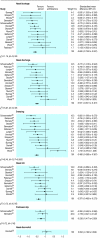Intranasal corticosteroids versus oral H1 receptor antagonists in allergic rhinitis: systematic review of randomised controlled trials
- PMID: 9848901
- PMCID: PMC28740
- DOI: 10.1136/bmj.317.7173.1624
Intranasal corticosteroids versus oral H1 receptor antagonists in allergic rhinitis: systematic review of randomised controlled trials
Abstract
Objective: To determine whether intranasal corticosteroids are superior to oral H1 receptor antagonists (antihistamines) in the treatment of allergic rhinitis.
Design: Meta-analysis of randomised controlled trials comparing intranasal corticosteroids with oral antihistamines.
Setting: Randomised controlled trials conducted worldwide and published between 1966 and 1997.
Subjects: 2267 subjects with allergic rhinitis in 16 randomised controlled trials.
Main outcome measures: Nasal blockage, nasal discharge, sneezing, nasal itch, postnasal drip, nasal discomfort, total nasal symptoms, nasal resistance, and eye symptoms and global ratings. Outcomes measured on different scales were combined to determine pooled odds ratios (categorical outcomes) or standardised mean differences (continuous outcomes). Assessment of heterogeneity between studies, and subgroup analyses of eye symptoms, were undertaken.
Results: Intranasal corticosteroids produced significantly greater relief than oral antihistamines of nasal blockage (standardised mean difference 0.63, 95% confidence interval - 0.73 to - 0.53), nasal discharge (-0.5, - 0.6 to - 0.4), sneezing (- 0.49, - 0.59 to - 0.39), nasal itch (- 0.38,- 0.49 to - 0.21), postnasal drip (- 0.24,- 0.42 to - 0.06), and total nasal symptoms (- 0.42,- 0.53 to - 0.32), and global ratings gave an odds ratio for deterioration of symptoms of 0.26 (0.08 to 0.8). There were no significant differences between treatments for nasal discomfort, nasal resistance, or eye symptoms. The effects on sneezing, total nasal symptoms, and eye symptoms were significantly heterogeneous between studies. Other combined outcomes were homogeneous between studies. Subgroup analysis of the outcome of eye symptoms suggested that the duration of assessment (averaged mean score over the study period versus mean score at end of study period) might have accounted for the heterogeneity.
Conclusion: The results of this systematic review, together with data on safety and cost effectiveness, support the use of intranasal corticosteroids over oral antihistamines as first line treatment for allergic rhinitis.
Figures



Comment in
-
Intranasal corticosteroids in allergic rhinitis. Evidence of efficacy is useful but not only factor to be considered.BMJ. 1999 May 15;318(7194):1350-1. BMJ. 1999. PMID: 10383210 No abstract available.
Similar articles
-
Intranasal Versus Oral Treatments for Allergic Rhinitis: A Systematic Review With Meta-Analysis.J Allergy Clin Immunol Pract. 2024 Dec;12(12):3404-3418. doi: 10.1016/j.jaip.2024.09.001. Epub 2024 Sep 7. J Allergy Clin Immunol Pract. 2024. PMID: 39251016
-
Comparison of intranasal corticosteroids and antihistamines in allergic rhinitis: a review of randomized, controlled trials.Am J Respir Med. 2003;2(1):55-65. doi: 10.1007/BF03256639. Am J Respir Med. 2003. PMID: 14720022 Review.
-
Intranasal corticosteroids for allergic rhinitis: superior relief?Drugs. 2001;61(11):1563-79. doi: 10.2165/00003495-200161110-00004. Drugs. 2001. PMID: 11577794 Review.
-
Effectiveness of intranasal corticosteroids.Acta Biomed. 2004 Apr;75(1):22-5. Acta Biomed. 2004. PMID: 15315083
-
Intranasal antihistamine is superior to oral H1 antihistamine as an add-on therapy to intranasal corticosteroid for treating allergic rhinitis.Ann Allergy Asthma Immunol. 2020 Nov;125(5):589-596.e3. doi: 10.1016/j.anai.2020.06.038. Epub 2020 Jul 7. Ann Allergy Asthma Immunol. 2020. PMID: 32650045
Cited by
-
Allergic rhinitis: Review of the diagnosis and management: South African Allergic Rhinitis Working Group.S Afr Fam Pract (2004). 2023 Oct 30;65(1):e1-e11. doi: 10.4102/safp.v65i1.5806. S Afr Fam Pract (2004). 2023. PMID: 37916698 Free PMC article. Review.
-
Allergic rhinitis.Allergy Asthma Clin Immunol. 2024 Dec 27;20(Suppl 3):74. doi: 10.1186/s13223-024-00923-6. Allergy Asthma Clin Immunol. 2024. PMID: 39731198 Free PMC article. Review.
-
Role of antioxidants on the clinical outcome of patients with perennial allergic rhinitis.Allergy Rhinol (Providence). 2016 Jan;7(2):74-81. doi: 10.2500/ar.2016.7.0163. Allergy Rhinol (Providence). 2016. PMID: 27658183 Free PMC article.
-
Impact of sleep as a specific marker of quality of life in allergic rhinitis.Curr Allergy Asthma Rep. 2013 Apr;13(2):131-41. doi: 10.1007/s11882-012-0330-z. Curr Allergy Asthma Rep. 2013. PMID: 23247762 Review.
-
Allergic rhinoconjunctivitis in elite athletes: optimal management for quality of life and performance.Sports Med. 2003;33(6):401-6. doi: 10.2165/00007256-200333060-00002. Sports Med. 2003. PMID: 12744714 Review.
References
-
- International Rhinitis Management Working Group. International consensus report on the diagnosis and management of rhinitis. Allergy. 1994;49(suppl 19):1–34. - PubMed
-
- Aberg N. Asthma and allergic rhinitis in Swedish conscripts. Clin Exp Allergy. 1989;19:59–63. - PubMed
-
- Hopper T, Jenkin M, Carlin C, Giles G. Increase in the self-reported prevalence of asthma and hay fever in adults over the past generation. Aust J Pub Health. 1995;19:120–124. - PubMed
-
- Australian Bureau of Statistics, 1989-90. National health survey. Asthma and other respiratory conditions. Australia: Commonwealth Government Printer; 1991.
Publication types
MeSH terms
Substances
Grants and funding
LinkOut - more resources
Full Text Sources
Other Literature Sources
Medical
Research Materials
